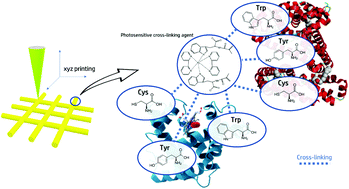In situ and non-cytotoxic cross-linking strategy for 3D printable biomaterials†
Abstract
3D bioprinting allows the production of patient-specific tissue constructs with desired structural characteristics such as high resolution, controlled swelling degree, and controlled degradation behavior by mostly using hydrogels. Crosslinking of hydrogels is an essential parameter in bioprinting applications, which is beneficial for tuning structural specifications. In this study, gelatin–alginate–whey protein isolate based hydrogels have been used for 3D printing structures in a layer-by-layer fashion. These structures were cross-linked by the Amino Acid (monomer) Decorated and Light Underpinning Conjugation Approach (ANADOLUCA) method, which is a unique, non-invasive photosensitive cross-linking technique for protein-based mixtures. In that aim, hydrogel properties (e.g., printability, biocompatibility, rheologic and mechanical behavior) and cross-linking properties (e.g., swelling and degradation behavior) were studied. Results were compared with UV and ionic cross-linking techniques, which are the abundantly used techniques in such studies. The results showed that the ANADOLUCA method can be used for in situ cross-linking under mild conditions for the printing of bio-inks, and the proposed method can be used as an alternative for UV-based and chemical cross-linking techniques.



 Please wait while we load your content...
Please wait while we load your content...